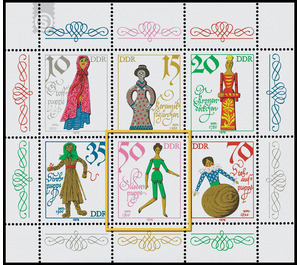Historical dolls - Germany / German Democratic Republic 1979 - 50 Pfennig
Theme: Devices, Items & Instruments
| Country | Germany / German Democratic Republic |
| Issue Date | 1979 |
| Face Value | 50.00 |
| Color | multi-colored |
| Perforation | K 14 |
| Printing Type | offset |
| Stamp Type | Postage stamp |
| Item Type | Stamp |
| Chronological Issue Number | 2218 |
| Chronological Chapter | GER-DDR |
| SID | 883819 |
| In 15 Wishlists | |
Historical dolls With motifs of historical dolls, the Ministry of Posts and Telecommunications of the German Democratic Republic issues six multicolored special postage stamps. The six postage stamps are printed together on a miniature sheet. No special first-day cover envelope Historical Dolls Among all toys, dolls take on a special place as miniaturized images of humans. Playing with the doll, the children creatively shape the environment in which they live, enriching their social environment and enriching their social relationships. Through the design of the doll, society influences the children's play in the sense of its educational and educational goals. Through its wealth of forms, materials and techniques, the doll reflects in its history in many ways the cultural development of human society and bears testimony to the creative abilities of its producers as well as to the very different efforts of society in the play of the child in the course of Story. The bow spans from primitive forms of the doll, which, made from simple materials for their own use, were playing with tribes and peoples on a low level of social development, to the industrially manufactured dolls of our time. The dolls on the special postage stamp miniature sheet have in common that they have been made manually, in manual work for personal use or for sale. The next step in the development of the doll represents the wooden mannequin (50 Pfennig). This type of doll, which was also made in the Sonneberg area, needed clothing and thus opened up the way for fashion to influence the external design of the doll. Apparently dressed mannequins were sold in the 18th and at the beginning of the 19th century in large numbers via Holland to England, as they appeared there under the name "Dutch Dolls". The precious clothing of these dolls made them a toy of wealthy strata.


